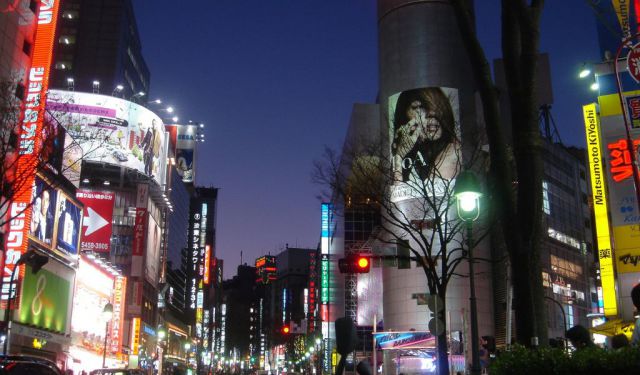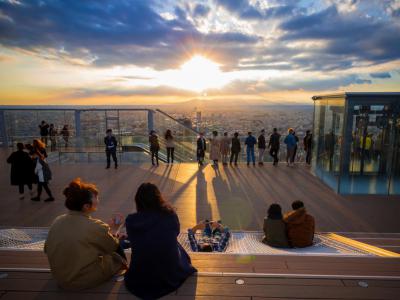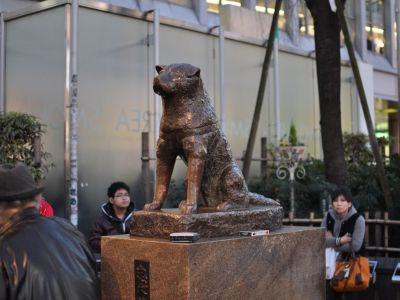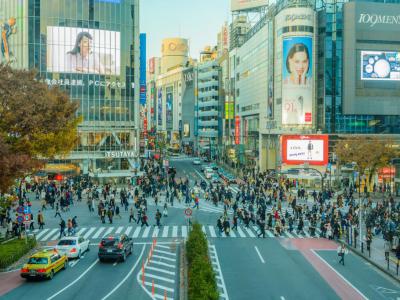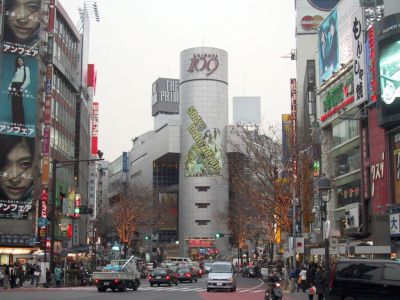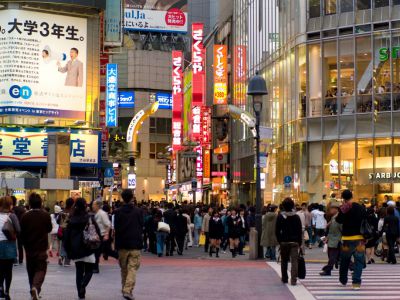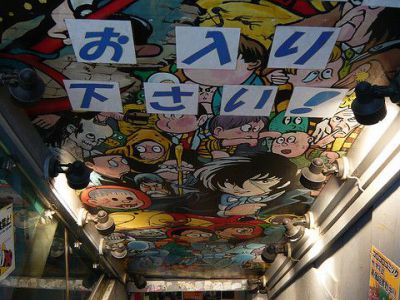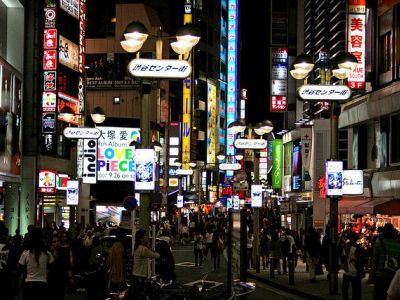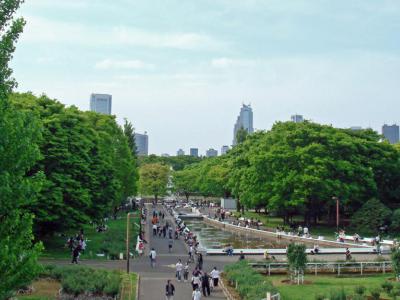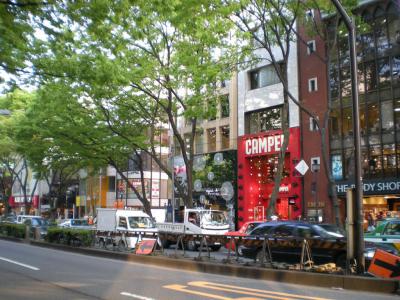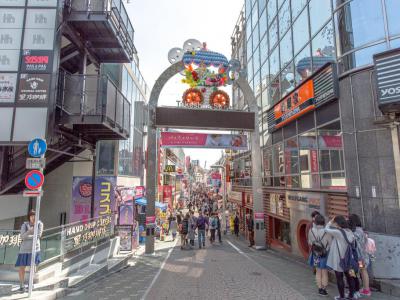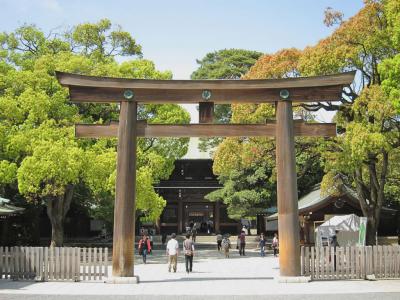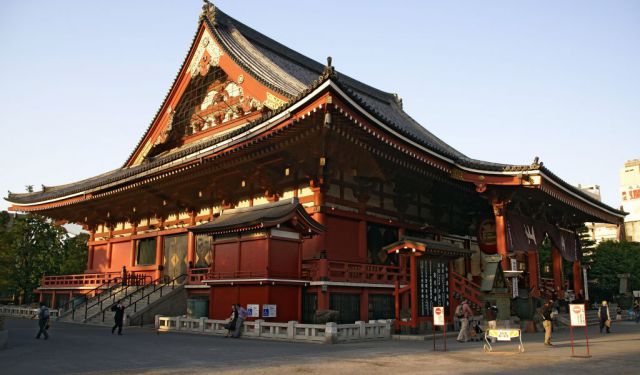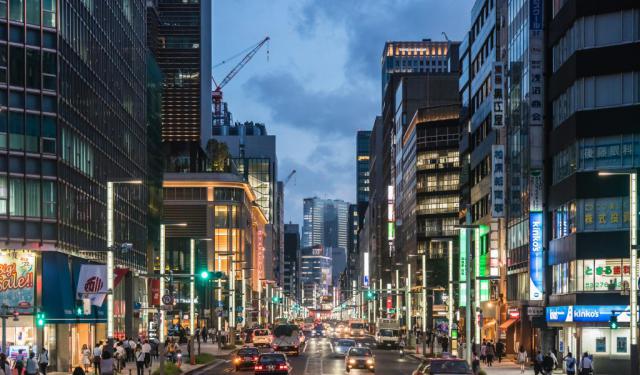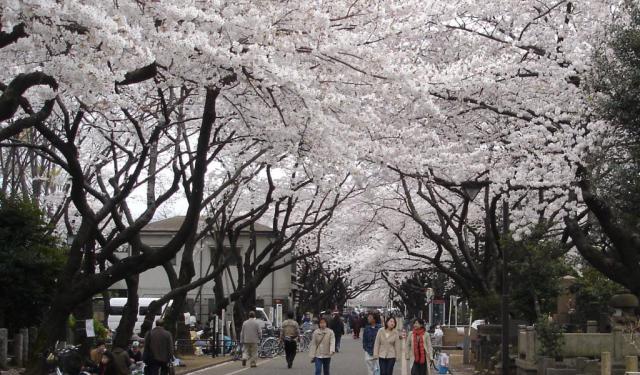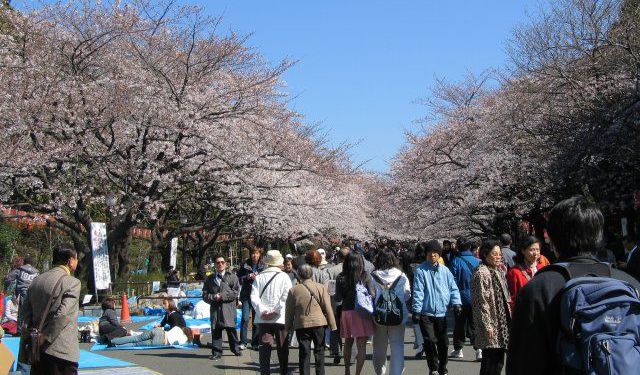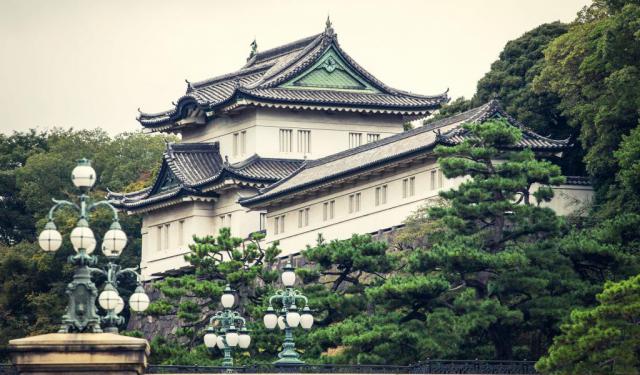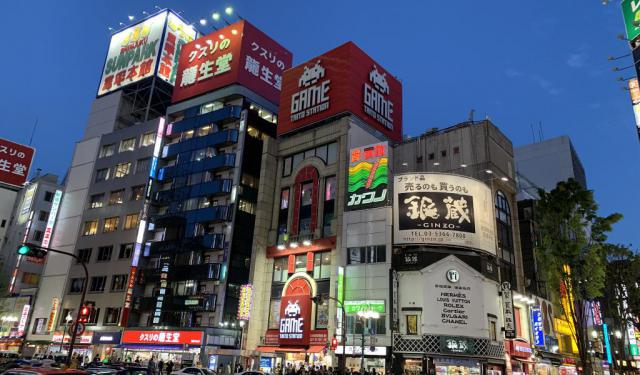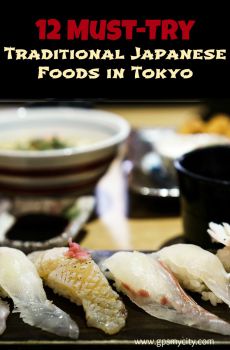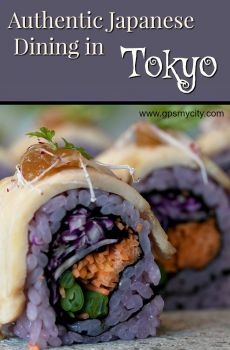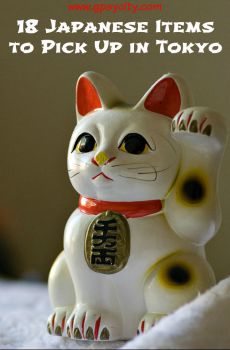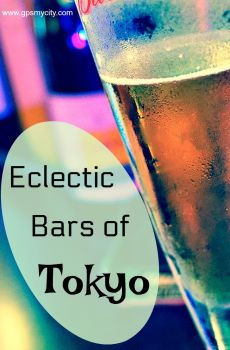Audio Guide: Shibuya Walking Tour (Self Guided), Tokyo
Ah, Shibuya... If Tokyo were a giant party, this district would be the dance floor. A neon-lit playground where fashion-forward teens, pop culture fiends, and wide-eyed tourists collide in a kaleidoscope of color, style, and pure urban energy.
But before it became Japan’s trendsetting capital, Shibuya had a different kind of ruling class-the Shibuya clan. Back in the 1160s, they ran this place, right up until another clan took over in 1524. Fast forward through the Edo period, the Tokyo Olympics, and the rise of modern skyscrapers, and you’ve got the Shibuya we know today.
The heartbeat of it all is Shibuya Scramble Crossing. Imagine hundreds of people stepping off the curb at once, flowing like a perfectly choreographed flash mob-except no one rehearsed, and somehow, it just works.
A few hundred steps away, the Hachiko Statue stands as a touching tribute to Japan’s most loyal pup. This furry icon waited for his owner every single day at Shibuya Station-proof that some commitments last longer than your New Year’s resolutions.
Now, if shopping is your cardio, Shibuya 109 is your gym. This iconic mall is a haven for the latest trends, where fashionistas hunt for statement pieces like it’s a competitive sport. For a more eclectic mix, Center-Gai Shopping Street serves up a fusion of boutiques, street snacks, and just the right amount of chaos.
And for the pop culture enthusiasts? Mandarake is where anime, manga, and collector’s dreams come true. Think of it as a treasure trove of nostalgia-if nostalgia came in the form of rare action figures and vintage comics.
But wait, there’s more! Escape the neon buzz and head north to Yoyogi Park, where Tokyo takes a deep breath. A place to swap city noise for birdsong, grab a picnic, or simply people-watch in blissful peace. Right next door, the Meiji Jingu Shrine offers a dose of tradition, spirituality, and some much-needed serenity.
Then there’s Omotesando Avenue, where high-end fashion reigns supreme, and Takeshita Street in Harajuku, the undisputed capital of quirky, creative, and downright unexpected styles. If you ever wanted to see a goth Lolita share a sidewalk with a neon-clad Kawaii icon, this is your spot.
Anyone who's a trendsetter, a culture vulture, or just here to soak up the electric Tokyo vibe will find Shibuya their scene. So lace up those walking shoes (or platform boots, if you dare), charge your phone for all the Instagram-worthy moments, and dive into the organized chaos that is Shibuya.
But fair warning: once you’ve experienced Shibuya, normal city streets might feel just a little too... tame.
But before it became Japan’s trendsetting capital, Shibuya had a different kind of ruling class-the Shibuya clan. Back in the 1160s, they ran this place, right up until another clan took over in 1524. Fast forward through the Edo period, the Tokyo Olympics, and the rise of modern skyscrapers, and you’ve got the Shibuya we know today.
The heartbeat of it all is Shibuya Scramble Crossing. Imagine hundreds of people stepping off the curb at once, flowing like a perfectly choreographed flash mob-except no one rehearsed, and somehow, it just works.
A few hundred steps away, the Hachiko Statue stands as a touching tribute to Japan’s most loyal pup. This furry icon waited for his owner every single day at Shibuya Station-proof that some commitments last longer than your New Year’s resolutions.
Now, if shopping is your cardio, Shibuya 109 is your gym. This iconic mall is a haven for the latest trends, where fashionistas hunt for statement pieces like it’s a competitive sport. For a more eclectic mix, Center-Gai Shopping Street serves up a fusion of boutiques, street snacks, and just the right amount of chaos.
And for the pop culture enthusiasts? Mandarake is where anime, manga, and collector’s dreams come true. Think of it as a treasure trove of nostalgia-if nostalgia came in the form of rare action figures and vintage comics.
But wait, there’s more! Escape the neon buzz and head north to Yoyogi Park, where Tokyo takes a deep breath. A place to swap city noise for birdsong, grab a picnic, or simply people-watch in blissful peace. Right next door, the Meiji Jingu Shrine offers a dose of tradition, spirituality, and some much-needed serenity.
Then there’s Omotesando Avenue, where high-end fashion reigns supreme, and Takeshita Street in Harajuku, the undisputed capital of quirky, creative, and downright unexpected styles. If you ever wanted to see a goth Lolita share a sidewalk with a neon-clad Kawaii icon, this is your spot.
Anyone who's a trendsetter, a culture vulture, or just here to soak up the electric Tokyo vibe will find Shibuya their scene. So lace up those walking shoes (or platform boots, if you dare), charge your phone for all the Instagram-worthy moments, and dive into the organized chaos that is Shibuya.
But fair warning: once you’ve experienced Shibuya, normal city streets might feel just a little too... tame.
How it works: Download the app "GPSmyCity: Walks in 1K+ Cities" from Apple App Store or Google Play Store to your mobile phone or tablet. The app turns your mobile device into a personal tour guide and its built-in GPS navigation functions guide you from one tour stop to next. The app works offline, so no data plan is needed when traveling abroad.
Shibuya Walking Tour Map
Guide Name: Shibuya Walking Tour
Guide Location: Japan » Tokyo (See other walking tours in Tokyo)
Guide Type: Self-guided Walking Tour (Sightseeing)
# of Attractions: 11
Tour Duration: 2 Hour(s)
Travel Distance: 3.9 Km or 2.4 Miles
Author: DanaOffice
Sight(s) Featured in This Guide:
Guide Location: Japan » Tokyo (See other walking tours in Tokyo)
Guide Type: Self-guided Walking Tour (Sightseeing)
# of Attractions: 11
Tour Duration: 2 Hour(s)
Travel Distance: 3.9 Km or 2.4 Miles
Author: DanaOffice
Sight(s) Featured in This Guide:
- Shibuya Scramble Square
- Hachiko Statue
- Shibuya Crossing
- Shibuya 109
- Center-gai Shopping Street
- Mandarake
- Koen-dori Shopping Street
- Yoyogi Park
- Omotesando Avenue
- Takeshita Street
- Meiji Jingu Shrine
1) Shibuya Scramble Square
Check out Shibuya Scramble Square, the towering titan of Tokyo’s trendiest district. Standing at a whopping 750 feet (or 229 meters) tall, this sleek skyscraper isn’t just the tallest building in Shibuya-it is also the perfect spot to remind yourself how tiny you are in the grand scheme of things.
Construction of this 46-story giant kicked off in 2014, with the East Tower officially opening in 2019. And because Tokyo never stops leveling up, the rest of the complex remained under construction long after, set for completion in 2027. So, if you ever feel like you’re running behind on deadlines, just remember-even skyscrapers take their time.
But let’s talk about the real star of the show: Shibuya Sky-the rooftop observation deck. This isn’t just any deck; it’s three decks in one. Here, you’ve got the Sky Gallery (for those who love sleek, futuristic vibes), the Sky Gate (to get you there in style), and the Sky Stage, where you can soak in a 360-degree view of Tokyo that’s so stunning, you might actually forget to take a selfie. Access to this sky-high spectacle will set you back around $20-a small price to pay for the ultimate "top of the world" moment.
And when you’re done feeling like a god among mortals, head back down and shop till you drop at over 200 stores. Hunting for high-tech gadgets, fashion-forward apparel, or the perfect Instagrammable snack? This place has it all. Speaking of food, the restaurants here range from Western-inspired sweets to traditional Japanese cuisine-so whether you’re craving a delicate matcha dessert or a hearty ramen bowl, you’ll leave satisfied (and possibly in need of an escalator nap).
Regardless of your purpose-be it shopping, eating, or getting a literal bird’s-eye view of Tokyo-Shibuya Scramble Square delivers you an ultimate experience, one floor at a time. Just don’t look down. Or do. It’s worth it.
Construction of this 46-story giant kicked off in 2014, with the East Tower officially opening in 2019. And because Tokyo never stops leveling up, the rest of the complex remained under construction long after, set for completion in 2027. So, if you ever feel like you’re running behind on deadlines, just remember-even skyscrapers take their time.
But let’s talk about the real star of the show: Shibuya Sky-the rooftop observation deck. This isn’t just any deck; it’s three decks in one. Here, you’ve got the Sky Gallery (for those who love sleek, futuristic vibes), the Sky Gate (to get you there in style), and the Sky Stage, where you can soak in a 360-degree view of Tokyo that’s so stunning, you might actually forget to take a selfie. Access to this sky-high spectacle will set you back around $20-a small price to pay for the ultimate "top of the world" moment.
And when you’re done feeling like a god among mortals, head back down and shop till you drop at over 200 stores. Hunting for high-tech gadgets, fashion-forward apparel, or the perfect Instagrammable snack? This place has it all. Speaking of food, the restaurants here range from Western-inspired sweets to traditional Japanese cuisine-so whether you’re craving a delicate matcha dessert or a hearty ramen bowl, you’ll leave satisfied (and possibly in need of an escalator nap).
Regardless of your purpose-be it shopping, eating, or getting a literal bird’s-eye view of Tokyo-Shibuya Scramble Square delivers you an ultimate experience, one floor at a time. Just don’t look down. Or do. It’s worth it.
2) Hachiko Statue
This story began in 1923, on a farm near Odate in Akita Prefecture, where a fluffy little pup named Hachiko took his first wobbly steps into history. This golden brown Akita was destined for greatness-not in a heroic, dragon-slaying way, but in a quietly loyal, heartbreakingly devoted way that would put even the most dedicated pet to shame.
Hidesaburo Ueno, a professor at the University of Tokyo, adopted Hachiko in 1924, and just like that, a legendary bond was formed. Every evening, like clockwork, Hachiko would trot down to Shibuya Station to greet his beloved owner, tail wagging, ears perked. It was their little ritual-until, one day, it wasn’t.
When Professor Ueno suddenly passed away, most would have expected Hachiko to move on. But no. This dog was built different. For the next 9 years, 9 months, and 15 days, he showed up at the station, waiting. Rain or shine. Through changing seasons, shifting crowds, and the march of time itself. And in doing so, he captured the hearts of an entire nation.
By 1934, Japan had fallen so deeply in love with this steadfast Akita that they immortalized him in bronze. Hachiko himself was present for the grand unveiling, probably wondering why his own face was suddenly staring back at him. But wartime came, and the statue was melted down for the war effort-because back then, apparently, nothing was sacred.
Thankfully, in 1948, a new statue was commissioned by none other than the original artist’s son. And today, Hachiko stands proudly once again at Shibuya Station, forever waiting. The nearby station exit is even named after him-the Hachiko Exit, a major landmark and meeting point in the city.
Speaking of which, just beyond that exit is Shibuya Crossing, Tokyo’s most iconic human stampede, where hundreds-sometimes thousands-of people cross in a beautifully choreographed spectacle of urban energy.
If you’re visiting Shibuya for shopping, nightlife, or just to people-watch, make sure to stop by and say hello to the "goodest" boy in history. And if you’re running late? Don’t worry-Hachiko’s used to waiting. Should you ever feel like giving up on someone, just remember, this dog waited almost a decade…
Hidesaburo Ueno, a professor at the University of Tokyo, adopted Hachiko in 1924, and just like that, a legendary bond was formed. Every evening, like clockwork, Hachiko would trot down to Shibuya Station to greet his beloved owner, tail wagging, ears perked. It was their little ritual-until, one day, it wasn’t.
When Professor Ueno suddenly passed away, most would have expected Hachiko to move on. But no. This dog was built different. For the next 9 years, 9 months, and 15 days, he showed up at the station, waiting. Rain or shine. Through changing seasons, shifting crowds, and the march of time itself. And in doing so, he captured the hearts of an entire nation.
By 1934, Japan had fallen so deeply in love with this steadfast Akita that they immortalized him in bronze. Hachiko himself was present for the grand unveiling, probably wondering why his own face was suddenly staring back at him. But wartime came, and the statue was melted down for the war effort-because back then, apparently, nothing was sacred.
Thankfully, in 1948, a new statue was commissioned by none other than the original artist’s son. And today, Hachiko stands proudly once again at Shibuya Station, forever waiting. The nearby station exit is even named after him-the Hachiko Exit, a major landmark and meeting point in the city.
Speaking of which, just beyond that exit is Shibuya Crossing, Tokyo’s most iconic human stampede, where hundreds-sometimes thousands-of people cross in a beautifully choreographed spectacle of urban energy.
If you’re visiting Shibuya for shopping, nightlife, or just to people-watch, make sure to stop by and say hello to the "goodest" boy in history. And if you’re running late? Don’t worry-Hachiko’s used to waiting. Should you ever feel like giving up on someone, just remember, this dog waited almost a decade…
3) Shibuya Crossing (must see)
Shibuya Crossing-perhaps the world’s most beautifully chaotic intersection and a masterclass in organized mayhem. If Tokyo had a pulse, this would be it.
Smack in front of Shibuya Station’s Hachiko Exit, this legendary scramble crossing brings traffic to a full stop so pedestrians-up to 2,500 at a time-can flood the intersection from all angles. It’s less of a crosswalk and more of a synchronized urban ballet, where the lead dancers are salarymen, fashionistas, and tourists all trying to film the perfect slow-mo shot.
Speaking of Hachiko, his statue stands nearby, serving as a popular meeting spot. This means, if you’ve made plans to rendezvous in Shibuya, you’re probably standing there right now, trying to locate your friend in a sea of selfie sticks.
Above the crossing, three giant TV screens and a neon explosion of billboards scream for attention, making this Japan’s answer to Times Square (of New York City) or Piccadilly Circus (of London)-just with a little extra flair. Oh, and see that Starbucks with the perfect aerial view? It’s one of the busiest in the world, which means securing a window seat is basically a competitive sport.
But Shibuya Crossing isn’t just a Tokyo landmark-it’s a Hollywood favorite. It’s made cameos in "Lost in Translation," "Tokyo Drift," "Resident Evil"-and even gets its own starring role in the video game "The World Ends With You." If you’ve ever seen a film set in Tokyo, chances are, this intersection had its moment of fame.
Come to think of it, Shibuya Crossing is neither a pedestrian crossing as such but a phenomenon. A symbol of Tokyo’s non-stop energy, its cinematic charm, and its ability to turn a simple walk across the street into an unforgettable experience.
So go ahead, step into the scramble-just don’t forget to look up and take it all in. And if you manage to make it across without stopping for a selfie… well, congratulations, you might be the only one.
Smack in front of Shibuya Station’s Hachiko Exit, this legendary scramble crossing brings traffic to a full stop so pedestrians-up to 2,500 at a time-can flood the intersection from all angles. It’s less of a crosswalk and more of a synchronized urban ballet, where the lead dancers are salarymen, fashionistas, and tourists all trying to film the perfect slow-mo shot.
Speaking of Hachiko, his statue stands nearby, serving as a popular meeting spot. This means, if you’ve made plans to rendezvous in Shibuya, you’re probably standing there right now, trying to locate your friend in a sea of selfie sticks.
Above the crossing, three giant TV screens and a neon explosion of billboards scream for attention, making this Japan’s answer to Times Square (of New York City) or Piccadilly Circus (of London)-just with a little extra flair. Oh, and see that Starbucks with the perfect aerial view? It’s one of the busiest in the world, which means securing a window seat is basically a competitive sport.
But Shibuya Crossing isn’t just a Tokyo landmark-it’s a Hollywood favorite. It’s made cameos in "Lost in Translation," "Tokyo Drift," "Resident Evil"-and even gets its own starring role in the video game "The World Ends With You." If you’ve ever seen a film set in Tokyo, chances are, this intersection had its moment of fame.
Come to think of it, Shibuya Crossing is neither a pedestrian crossing as such but a phenomenon. A symbol of Tokyo’s non-stop energy, its cinematic charm, and its ability to turn a simple walk across the street into an unforgettable experience.
So go ahead, step into the scramble-just don’t forget to look up and take it all in. And if you manage to make it across without stopping for a selfie… well, congratulations, you might be the only one.
4) Shibuya 109
Shibuya 109 is where Tokyo’s fashionistas come to play! Think of it as a multi-level temple of trends-ten floors of pure style adrenaline, packed with over a hundred boutiques catering to the city’s most fashion-forward young women.
Now, let’s drop some history! The building stands on what was once Koibumi Yokocho-aka Love Letter Lane. Romantic, right? But in 1979, architect Minoru Takeyama swapped out love notes for retail therapy, creating a cylindrical shopping wonderland. Why 109? It’s a nod to the Tokyu Group, which owns the place-because every “fashion empire” needs its own cryptic numerical code.
Inside, shoppers move through the floors in an endless loop of retail discovery, navigating the sleek elevators while getting a panoramic view of every dazzling boutique. The building is home to small designers and trendsetters, offering the latest and greatest in Japanese streetwear. And let’s not forget the Kogal subculture-this is where it was born! If you’re picturing platform boots, miniskirts, sun-kissed tans, and enough accessories to outshine a jewelry store-yep, you’ve got the vibe.
Why visit here? Because even if you don’t squeeze into Tokyo’s tiniest trendy outfits, the experience is fashion gold! The accessories are absolutely adorable. The style? Straight-up Harajuku-meets-high-glam. And the energy is just electric.
So, put on those platform boots, grab your shopping bags, and enter Tokyo’s ultimate fashion vortex-Shibuya 109. But be warned: your wallet may experience some side effects.
Tip:
Don’t just browse one or two floors-commit to the full Shibuya 109 marathon. The best finds are scattered across all levels, and believe it, you don’t want to miss a thing!
Now, let’s drop some history! The building stands on what was once Koibumi Yokocho-aka Love Letter Lane. Romantic, right? But in 1979, architect Minoru Takeyama swapped out love notes for retail therapy, creating a cylindrical shopping wonderland. Why 109? It’s a nod to the Tokyu Group, which owns the place-because every “fashion empire” needs its own cryptic numerical code.
Inside, shoppers move through the floors in an endless loop of retail discovery, navigating the sleek elevators while getting a panoramic view of every dazzling boutique. The building is home to small designers and trendsetters, offering the latest and greatest in Japanese streetwear. And let’s not forget the Kogal subculture-this is where it was born! If you’re picturing platform boots, miniskirts, sun-kissed tans, and enough accessories to outshine a jewelry store-yep, you’ve got the vibe.
Why visit here? Because even if you don’t squeeze into Tokyo’s tiniest trendy outfits, the experience is fashion gold! The accessories are absolutely adorable. The style? Straight-up Harajuku-meets-high-glam. And the energy is just electric.
So, put on those platform boots, grab your shopping bags, and enter Tokyo’s ultimate fashion vortex-Shibuya 109. But be warned: your wallet may experience some side effects.
Tip:
Don’t just browse one or two floors-commit to the full Shibuya 109 marathon. The best finds are scattered across all levels, and believe it, you don’t want to miss a thing!
5) Center-gai Shopping Street
Center Gai, or as it’s now officially called, Basketball Street-because rebranding is everything, right?-is all about game arcades, cheap cafes, and the latest streetwear trends.
Stretching 350 meters from Shibuya Station to the Tokyu Department Store, this street is where fashion trends are born, Tokyo’s youth come out to play, and tourists wander in wide-eyed wonder (or confusion). It's a neon-lit runway of trendsetters, gamers, bargain hunters, and night owls looking for their next adventure-or just a decent snack.
Once upon a time, the street had a bit of a reputation. Nicknames like "Scary Street" and "Dirty Street" weren’t exactly great for tourism brochures. So, in a move of pure PR brilliance, they slapped a new name on it and called it Basketball Street-despite having no actual basketball courts, hoops, or, well… anything remotely basketball-related. But what it does have is the headquarters of Japan’s BJ League, hidden inside the nearby Yoyogi National Gymnasium, so let’s just roll with it.
If you want to experience Tokyo’s electric nightlife, do a bit of trend-spotting, and maybe get lost in a sea of blinking signs and loud music, this is the place. So get your sneakers (or platform boots, no judgment) handy and dive headfirst into Shibuya’s living, breathing, ever-trending street scene. Just don’t expect to find a basketball game happening anytime soon. And, if anyone asks, just nod and say, “Yeah, Basketball Street… totally makes sense.”
Tip:
Brace yourself for crowds-it’s part of the experience! And don’t just walk through-cross it from different angles, take some ridiculously cool photos, and then spend all your money at Loft or the ever-amazing Tokyu Hands. If shopping fatigue hits, the 9th-floor café at Tokyu Hands awaits, ready to recharge you for round two.
Stretching 350 meters from Shibuya Station to the Tokyu Department Store, this street is where fashion trends are born, Tokyo’s youth come out to play, and tourists wander in wide-eyed wonder (or confusion). It's a neon-lit runway of trendsetters, gamers, bargain hunters, and night owls looking for their next adventure-or just a decent snack.
Once upon a time, the street had a bit of a reputation. Nicknames like "Scary Street" and "Dirty Street" weren’t exactly great for tourism brochures. So, in a move of pure PR brilliance, they slapped a new name on it and called it Basketball Street-despite having no actual basketball courts, hoops, or, well… anything remotely basketball-related. But what it does have is the headquarters of Japan’s BJ League, hidden inside the nearby Yoyogi National Gymnasium, so let’s just roll with it.
If you want to experience Tokyo’s electric nightlife, do a bit of trend-spotting, and maybe get lost in a sea of blinking signs and loud music, this is the place. So get your sneakers (or platform boots, no judgment) handy and dive headfirst into Shibuya’s living, breathing, ever-trending street scene. Just don’t expect to find a basketball game happening anytime soon. And, if anyone asks, just nod and say, “Yeah, Basketball Street… totally makes sense.”
Tip:
Brace yourself for crowds-it’s part of the experience! And don’t just walk through-cross it from different angles, take some ridiculously cool photos, and then spend all your money at Loft or the ever-amazing Tokyu Hands. If shopping fatigue hits, the 9th-floor café at Tokyu Hands awaits, ready to recharge you for round two.
6) Mandarake
If Tokyo had a treasure vault for manga lovers, anime buffs, and collectors of all things nostalgic, it would have "Mandarake" written all over it. This legendary chain is Japan’s largest seller of manga collectibles, and luckily for you, there are three major places in Tokyo where you can dive into its wonderland of geeky goodness.
First up, Nakano Broadway-the mothership of Mandarake. Imagine a shopping mall where every store is a different portal into otaku heaven. Need rare fan-made comics? Check. Craving anime cels, pencil boards, CDs, posters, art books, or vintage video games? Covered. Feeling the urge to channel your inner anime character? There’s even a store for cosplay costumes. And if all that treasure hunting makes you thirsty, there’s a Maid Café ready to serve up cute overload with your coffee.
Next, we go underground-literally. The Shibuya Mandarake store is hidden two floors below ground, like a secret lair for collectors. But here’s the kicker: It’s not just for shopping. There’s a karaoke stage where you can belt out your favorite anime theme songs in between hunting for retro US toys, classic action figures, and manga rarities.
Finally, there’s Mandarake Ikebukuro, located near Tokyo Hands, where nostalgia meets nerd nirvana. Whether you’re after rare games, vintage toys from the 1960s and ‘70s, or exclusive Japanese anime merch, this place has something to make your inner collector do a happy dance.
Just be warned: you might walk in looking for one manga and walk out with an entire suitcase of collectibles. Don't say they didn't warn you. And hey, if you do end up needing an extra suitcase... Mandarake probably sells those too.
First up, Nakano Broadway-the mothership of Mandarake. Imagine a shopping mall where every store is a different portal into otaku heaven. Need rare fan-made comics? Check. Craving anime cels, pencil boards, CDs, posters, art books, or vintage video games? Covered. Feeling the urge to channel your inner anime character? There’s even a store for cosplay costumes. And if all that treasure hunting makes you thirsty, there’s a Maid Café ready to serve up cute overload with your coffee.
Next, we go underground-literally. The Shibuya Mandarake store is hidden two floors below ground, like a secret lair for collectors. But here’s the kicker: It’s not just for shopping. There’s a karaoke stage where you can belt out your favorite anime theme songs in between hunting for retro US toys, classic action figures, and manga rarities.
Finally, there’s Mandarake Ikebukuro, located near Tokyo Hands, where nostalgia meets nerd nirvana. Whether you’re after rare games, vintage toys from the 1960s and ‘70s, or exclusive Japanese anime merch, this place has something to make your inner collector do a happy dance.
Just be warned: you might walk in looking for one manga and walk out with an entire suitcase of collectibles. Don't say they didn't warn you. And hey, if you do end up needing an extra suitcase... Mandarake probably sells those too.
7) Koen-dori Shopping Street
Koen-dori street is where shopping meets spectacle, and Tokyo’s trendsetters strut their stuff. In essence, this shopping street is 450 meters of pure retail and entertainment magic, stretching from the Marui City Department Store all the way to the Shibuya City Office.
And no, Koen-dori isn’t just about flexing your wallet. It’s a stage, a runway, and a concert venue all rolled into one. Street musicians, dancers, and performers turn the pavement into their personal spotlight, giving you a free front-row seat to some seriously talented acts.
Still, if shopping is your passion, you’re in the right place. This street is lined with department stores, high-end boutiques, and fashion hubs that attract the effortlessly stylish and the internationally curious. And let’s not forget the NHK Broadcasting Center-because what’s a street full of pop culture without the national media giant keeping tabs on it?
Then there’s the Yoyogi Stadium, which doesn’t just host sports events-it’s also the backdrop for music festivals and legendary concerts. Speaking of music, Koen-dori has its fair share of big-name venues, from the CC Lemon Concert Hall to the now-iconic Shibuya-AX.
Now, if you’re looking for THE place to shop, hang out, and soak up Tokyo’s energy, Parco is it. This two-building, multi-floor shopping wonderland has everything: fashion, food, theaters, an art gallery, a club-you name it. If Shibuya had a living room, this would be it.
Feeling a little overwhelmed by all this excitement? There’s a guidebook for that! Download an English shopping guide for Koen-dori (http://www.koen-dori.com/guidebook/guidebook_en.pdf) and map out your retail adventure. You’re gonna need it.
So, come for a bit of shopping at Koen-dori and stay for the vibes… and maybe, just maybe, leave with a new wardrobe.
And no, Koen-dori isn’t just about flexing your wallet. It’s a stage, a runway, and a concert venue all rolled into one. Street musicians, dancers, and performers turn the pavement into their personal spotlight, giving you a free front-row seat to some seriously talented acts.
Still, if shopping is your passion, you’re in the right place. This street is lined with department stores, high-end boutiques, and fashion hubs that attract the effortlessly stylish and the internationally curious. And let’s not forget the NHK Broadcasting Center-because what’s a street full of pop culture without the national media giant keeping tabs on it?
Then there’s the Yoyogi Stadium, which doesn’t just host sports events-it’s also the backdrop for music festivals and legendary concerts. Speaking of music, Koen-dori has its fair share of big-name venues, from the CC Lemon Concert Hall to the now-iconic Shibuya-AX.
Now, if you’re looking for THE place to shop, hang out, and soak up Tokyo’s energy, Parco is it. This two-building, multi-floor shopping wonderland has everything: fashion, food, theaters, an art gallery, a club-you name it. If Shibuya had a living room, this would be it.
Feeling a little overwhelmed by all this excitement? There’s a guidebook for that! Download an English shopping guide for Koen-dori (http://www.koen-dori.com/guidebook/guidebook_en.pdf) and map out your retail adventure. You’re gonna need it.
So, come for a bit of shopping at Koen-dori and stay for the vibes… and maybe, just maybe, leave with a new wardrobe.
8) Yoyogi Park
Yoyogi Park is Tokyo’s backyard. Here, the city unwinds, musicians jam, and martial artists practice moves that would make an action hero jealous. Nestled between Harajuku Station and Meiji Shrine, this green haven is where Sundays turn into a festival of impromptu concerts, cycling sprees, and the occasional samurai-in-training.
But before it became Tokyo’s chill-out zone, Yoyogi Park had quite the résumé. Back in 1910, this very spot made history when Captain Yoshitoshi Tokugawa pulled off Japan’s first successful powered flight-proving that Tokyo was reaching for the skies long before skyscrapers took over.
Fast forward a few decades, and the area had a drastic career shift-first as an army parade ground, then known as Washington Heights, a post-WWII military housing complex for U.S. officers. Picture suburban America, but in the middle of Tokyo. Then came the 1964 Tokyo Olympics, and Yoyogi got its biggest makeover yet. The Yoyogi National Gymnasium was built to host swimming, diving, and basketball events. That stunning, wave-like structure still stands tall today, hosting concerts and major events.
By 1967, the space between the gymnasium and Meiji Shrine was transformed into what we now call Yoyogi Park-a sprawling playground for Tokyoites and visitors alike.
Nowadays, this is the spot for cherry blossom viewing in the spring, where people flock with picnic baskets, cameras, and probably a few too many snacks. With bike paths, sports courts, and rental bicycles, it is also a great place to work off all those ramen adventures.
Ultimately, Yoyogi Park is the perfect escape from Tokyo’s neon jungle-be it for a relaxing stroll, a jam session, or just some top-tier people-watching. And hey, if you suddenly feel the urge to break into a martial arts routine or start a drum circle-don’t worry, you won’t be the only one. Just maybe leave the flying experiments to Captain Tokugawa...
But before it became Tokyo’s chill-out zone, Yoyogi Park had quite the résumé. Back in 1910, this very spot made history when Captain Yoshitoshi Tokugawa pulled off Japan’s first successful powered flight-proving that Tokyo was reaching for the skies long before skyscrapers took over.
Fast forward a few decades, and the area had a drastic career shift-first as an army parade ground, then known as Washington Heights, a post-WWII military housing complex for U.S. officers. Picture suburban America, but in the middle of Tokyo. Then came the 1964 Tokyo Olympics, and Yoyogi got its biggest makeover yet. The Yoyogi National Gymnasium was built to host swimming, diving, and basketball events. That stunning, wave-like structure still stands tall today, hosting concerts and major events.
By 1967, the space between the gymnasium and Meiji Shrine was transformed into what we now call Yoyogi Park-a sprawling playground for Tokyoites and visitors alike.
Nowadays, this is the spot for cherry blossom viewing in the spring, where people flock with picnic baskets, cameras, and probably a few too many snacks. With bike paths, sports courts, and rental bicycles, it is also a great place to work off all those ramen adventures.
Ultimately, Yoyogi Park is the perfect escape from Tokyo’s neon jungle-be it for a relaxing stroll, a jam session, or just some top-tier people-watching. And hey, if you suddenly feel the urge to break into a martial arts routine or start a drum circle-don’t worry, you won’t be the only one. Just maybe leave the flying experiments to Captain Tokugawa...
9) Omotesando Avenue
Tokyo’s most stylish runway disguised as a street, Omotesando is a wide, tree-lined avenue where high fashion meets history, and luxury brands rub elbows with quirky boutiques. It’s the kind of place where you can sip on a meticulously crafted latte while deciding whether today is a Louis Vuitton kind of day or a Zara one. No judgment...
Back in the Taisho era (between 1912 and 1926), this iconic avenue-stretching from the Meiji Shrine (a sacred place dedicated to Emperor Meiji) to Aoyama Street-served as the grand entrance to the shrine itself. Presently, it’s less about emperors and more about exclusive designer showrooms and impeccably dressed pedestrians who look like they walked straight out of a fashion editorial.
Some luxury brand gurus even consider Omotesando one of Tokyo’s prime luxury destinations-and who are we to argue when Gucci, Alexander McQueen, and Prada are all here within strolling distance? Of course, if you’re more into fast fashion, H&M, Gap, and Zara are ready to supply the latest trends without the luxury price tag.
But Omotesando isn’t just about shopping-it’s an experience. Pop into Kiddyland for the latest must-have toys, browse the Laforet shopping complex for trendsetting streetwear, or dive into the Oriental Bazaar, a one-stop shop for all things traditionally Japanese. And if you wander off into the side streets, you’ll stumble upon Tokyo’s coziest cafes, hidden bars, and boutique stores brimming with personality.
On top of that, every March, Omotesando throws on some green and transforms into the home of Tokyo’s annual Saint Patrick’s Day Parade. Because, indeed, what kind of luxury fashion district in Japan can do without leprechauns, shamrocks, and a sea of people celebrating Irish culture?
You may be here to shop, sip, stroll, or just absorb the sheer fabulousness of it all, but note: your wallet might not leave as full as your shopping bags.
Back in the Taisho era (between 1912 and 1926), this iconic avenue-stretching from the Meiji Shrine (a sacred place dedicated to Emperor Meiji) to Aoyama Street-served as the grand entrance to the shrine itself. Presently, it’s less about emperors and more about exclusive designer showrooms and impeccably dressed pedestrians who look like they walked straight out of a fashion editorial.
Some luxury brand gurus even consider Omotesando one of Tokyo’s prime luxury destinations-and who are we to argue when Gucci, Alexander McQueen, and Prada are all here within strolling distance? Of course, if you’re more into fast fashion, H&M, Gap, and Zara are ready to supply the latest trends without the luxury price tag.
But Omotesando isn’t just about shopping-it’s an experience. Pop into Kiddyland for the latest must-have toys, browse the Laforet shopping complex for trendsetting streetwear, or dive into the Oriental Bazaar, a one-stop shop for all things traditionally Japanese. And if you wander off into the side streets, you’ll stumble upon Tokyo’s coziest cafes, hidden bars, and boutique stores brimming with personality.
On top of that, every March, Omotesando throws on some green and transforms into the home of Tokyo’s annual Saint Patrick’s Day Parade. Because, indeed, what kind of luxury fashion district in Japan can do without leprechauns, shamrocks, and a sea of people celebrating Irish culture?
You may be here to shop, sip, stroll, or just absorb the sheer fabulousness of it all, but note: your wallet might not leave as full as your shopping bags.
10) Takeshita Street
In Takeshita Street, fashion meets chaos, trends are born, and your credit card may or may not survive the experience.
Nestled in the heart of Harajuku, this 350-meter wonderland stretches from Harajuku Station to Meiji Dori, and for seven glorious hours a day-from 11 a.m. to 6 p.m.-it belongs exclusively to pedestrians. That means no cars, no bikes-just you, your shopping bags, and an army of trend-hungry fashionistas.
So, what’s the big deal? Well, Takeshita Street is the undisputed capital of “kawaii” culture, the place where pastel-colored frills, Gothic- and Lolita-style dresses, as well as oversized anime hoodies peacefully coexist. Whether you’re a die-hard fashion fan or just here for the spectacle, one thing’s for sure: you’ve never seen a shopping street quite like this.
The mix is a little bit of everything. Quirky independent boutiques, vintage shops, and places so trendy they’re basically fashion laboratories-testing out tomorrow’s biggest trends before the rest of the world even knows they exist. Sure, you’ll find some familiar names, too, like The Body Shop, McDonald's, and 7-Eleven, but let’s be honest-you’re not here for a cheeseburger.
Takeshita Street first strutted onto the scene in 1976, but it really hit its stride in the '90s, when it became ground zero for Japan’s most iconic subcultures. Hip-hop, Gothic, Lolita-you name it, Takeshita had it. And if it didn’t? Well, it probably showed up the next week.
By the mid-2000s, Chinese tourists arrived in droves, hunting down souvenirs, beauty products, and whatever treasure lurked in the 100-yen shops. And though Takeshita has evolved, one thing remains: this street is primarily about an experience rather than sheer shopping.
Oh, and for those wondering-yes, there are rules. No adult entertainment establishments. No shady business. Just pure, unfiltered, Harajuku magic.
For those seeking to shop, gawk, or question their entire wardrobe, Takeshita Street is a definite go-to. But beware-once you’ve stepped into this kawaii vortex, regular shopping streets may never be the same. So, proceed with caution... and maybe an extra suitcase.
Nestled in the heart of Harajuku, this 350-meter wonderland stretches from Harajuku Station to Meiji Dori, and for seven glorious hours a day-from 11 a.m. to 6 p.m.-it belongs exclusively to pedestrians. That means no cars, no bikes-just you, your shopping bags, and an army of trend-hungry fashionistas.
So, what’s the big deal? Well, Takeshita Street is the undisputed capital of “kawaii” culture, the place where pastel-colored frills, Gothic- and Lolita-style dresses, as well as oversized anime hoodies peacefully coexist. Whether you’re a die-hard fashion fan or just here for the spectacle, one thing’s for sure: you’ve never seen a shopping street quite like this.
The mix is a little bit of everything. Quirky independent boutiques, vintage shops, and places so trendy they’re basically fashion laboratories-testing out tomorrow’s biggest trends before the rest of the world even knows they exist. Sure, you’ll find some familiar names, too, like The Body Shop, McDonald's, and 7-Eleven, but let’s be honest-you’re not here for a cheeseburger.
Takeshita Street first strutted onto the scene in 1976, but it really hit its stride in the '90s, when it became ground zero for Japan’s most iconic subcultures. Hip-hop, Gothic, Lolita-you name it, Takeshita had it. And if it didn’t? Well, it probably showed up the next week.
By the mid-2000s, Chinese tourists arrived in droves, hunting down souvenirs, beauty products, and whatever treasure lurked in the 100-yen shops. And though Takeshita has evolved, one thing remains: this street is primarily about an experience rather than sheer shopping.
Oh, and for those wondering-yes, there are rules. No adult entertainment establishments. No shady business. Just pure, unfiltered, Harajuku magic.
For those seeking to shop, gawk, or question their entire wardrobe, Takeshita Street is a definite go-to. But beware-once you’ve stepped into this kawaii vortex, regular shopping streets may never be the same. So, proceed with caution... and maybe an extra suitcase.
11) Meiji Jingu Shrine (must see)
Tucked away in a lush forest of towering evergreens, Meiji Shrine is a full-blown sanctuary in the heart of Tokyo. Built to honor Emperor Meiji and Empress Shoken, this shrine celebrates their legacy in modernizing Japan, proving that emperors can leave behind more than just portraits and history books.
It all began with an iris garden-a favorite retreat of the royal couple-until the government decided it was prime real estate for something grander. The construction kicked off in 1915, showcasing Nagare-zukuri architecture with Japanese cypress and copper accents. By 1926, the shrine was fully complete.
Then came World War II, and the original structure was reduced to rubble. But thanks to public fundraising, Meiji Shrine made a comeback in 1958, proving that Tokyo never lets a good thing stay down for long.
Now, here’s where it gets really interesting-the surrounding forest is a 700,000-square-meter wonderland with 120,000 trees from 365 species, all donated from across Japan. And this woodland escape in the heart of the city isn't just for meditation and tree-hugging. New Year's first prayers? Absolutely. Shinto rituals? Plenty of those. Making wishes on wooden plaques? Of course.
The shrine's inner precinct (Naien) houses the buildings and a museum filled with royal memorabilia-because what’s a shrine without a little royal nostalgia? The outer precinct (Gaien) is where things get even more dynamic, featuring an art gallery of imperial life murals, sports venues (including the National Stadium), and the Meiji Memorial Hall, which once saw political action but now hosts the most elegant Shinto weddings you’ll ever see.
And if all that fresh air makes you peckish, no worries! There’s a charming café, a souvenir shop (with surprisingly reasonable prices!), and, for sake enthusiasts, a glorious display of stacked sake barrels-because nothing complements Japan’s sacred site quite as tastefully as a towering tribute to the country's favorite rice-based beverage.
Just don’t be surprised if you end up staying longer than planned-it’s that kind of place. And hey, if you do end up making a wish here, aim high-after all, Emperor Meiji helped modernize a whole nation. So, dream big.
Tip:
If you can, drop by on a Sunday-that’s when the Shinto weddings happen-traditional, colorful, and utterly mesmerizing. Plus, the entrance is free from sunrise to sunset.
It all began with an iris garden-a favorite retreat of the royal couple-until the government decided it was prime real estate for something grander. The construction kicked off in 1915, showcasing Nagare-zukuri architecture with Japanese cypress and copper accents. By 1926, the shrine was fully complete.
Then came World War II, and the original structure was reduced to rubble. But thanks to public fundraising, Meiji Shrine made a comeback in 1958, proving that Tokyo never lets a good thing stay down for long.
Now, here’s where it gets really interesting-the surrounding forest is a 700,000-square-meter wonderland with 120,000 trees from 365 species, all donated from across Japan. And this woodland escape in the heart of the city isn't just for meditation and tree-hugging. New Year's first prayers? Absolutely. Shinto rituals? Plenty of those. Making wishes on wooden plaques? Of course.
The shrine's inner precinct (Naien) houses the buildings and a museum filled with royal memorabilia-because what’s a shrine without a little royal nostalgia? The outer precinct (Gaien) is where things get even more dynamic, featuring an art gallery of imperial life murals, sports venues (including the National Stadium), and the Meiji Memorial Hall, which once saw political action but now hosts the most elegant Shinto weddings you’ll ever see.
And if all that fresh air makes you peckish, no worries! There’s a charming café, a souvenir shop (with surprisingly reasonable prices!), and, for sake enthusiasts, a glorious display of stacked sake barrels-because nothing complements Japan’s sacred site quite as tastefully as a towering tribute to the country's favorite rice-based beverage.
Just don’t be surprised if you end up staying longer than planned-it’s that kind of place. And hey, if you do end up making a wish here, aim high-after all, Emperor Meiji helped modernize a whole nation. So, dream big.
Tip:
If you can, drop by on a Sunday-that’s when the Shinto weddings happen-traditional, colorful, and utterly mesmerizing. Plus, the entrance is free from sunrise to sunset.
Walking Tours in Tokyo, Japan
Create Your Own Walk in Tokyo
Creating your own self-guided walk in Tokyo is easy and fun. Choose the city attractions that you want to see and a walk route map will be created just for you. You can even set your hotel as the start point of the walk.
Asakusa District Walking Tour
Asakusa - Tokyo’s delightful time machine with a modern metro stop. This is one of the rare areas in the city where you will find narrow alleys, traditional shops, temple markets, and geisha whispers still echoing off the rooftops. Think of it as Old Tokyo in HD.
Back in the Edo period (between 1603 and 1868), Asakusa got its groove thanks to some very rich guys - the rice storehouse keepers... view more
Tour Duration: 1 Hour(s)
Travel Distance: 1.1 Km or 0.7 Miles
Back in the Edo period (between 1603 and 1868), Asakusa got its groove thanks to some very rich guys - the rice storehouse keepers... view more
Tour Duration: 1 Hour(s)
Travel Distance: 1.1 Km or 0.7 Miles
Ginza Shopping Tour
Often compared with New York's Fifth Avenue, Ginza is the most luxurious shopping district in Tokyo. Its two main avenues running through the area, Chuo-dori Street and Harumi-dori Street, are lined with high-end boutiques, enormous department stores, and flagship stores of renowned international brands carrying a wealth of merchandise, from fashion and jewelry to electronics and cosmetics.
... view more
Tour Duration: 1 Hour(s)
Travel Distance: 1.6 Km or 1 Miles
... view more
Tour Duration: 1 Hour(s)
Travel Distance: 1.6 Km or 1 Miles
Yanaka Walking Tour
A bit away from Downtown Tokyo, Yanaka is a hidden spot with a lot to offer. This neighborhood is known for its narrow alleys, traditional wooden houses, izakaya pubs, and old-style shops. Having largely escaped the damage of World War II, Yanaka exudes the last-century charm of Tokyo's old town ambiance.
With a high concentration of ancient places of worship in the district, the air here... view more
Tour Duration: 1 Hour(s)
Travel Distance: 1.6 Km or 1 Miles
With a high concentration of ancient places of worship in the district, the air here... view more
Tour Duration: 1 Hour(s)
Travel Distance: 1.6 Km or 1 Miles
Ueno Park Walking Tour
Ueno Park is Tokyo’s ultimate mashup of history, nature, and culture! It started as part of the powerful Kanei-ji Temple during the Edo period, which lasted from 1603 to 1868. Back then, samurais roamed and shoguns ruled the country. In the 1870s, as Japan embraced modernization, the area was gentrified, turning into a public park. Today, it's a major attraction for travelers craving both a... view more
Tour Duration: 2 Hour(s)
Travel Distance: 3.9 Km or 2.4 Miles
Tour Duration: 2 Hour(s)
Travel Distance: 3.9 Km or 2.4 Miles
Tokyo Imperial Palace Walking Tour
Welcome to Tokyo’s greenest royal secret-The Imperial Palace-a majestic sprawl of tradition, tranquility, and top-tier landscaping. This is where Japan’s Emperor hangs his crown (figuratively speaking), nestled right in the city’s beating heart and surrounded by moats like something straight out of a storybook... or a really classy samurai movie.
Now, before you grab your crown and march... view more
Tour Duration: 2 Hour(s)
Travel Distance: 2.7 Km or 1.7 Miles
Now, before you grab your crown and march... view more
Tour Duration: 2 Hour(s)
Travel Distance: 2.7 Km or 1.7 Miles
Shinjuku Walking Tour
Known as the best entertainment district in Tokyo, Shinjuku abounds in venues where visitors can play, eat, and shop to their hearts' content all day long. Besides the endless list of fun, shopping, and dining options available, the district also offers some truly amazing sightseeing opportunities which are often underrated.
One of its iconic landmarks is the two towers of the... view more
Tour Duration: 1 Hour(s)
Travel Distance: 2.1 Km or 1.3 Miles
One of its iconic landmarks is the two towers of the... view more
Tour Duration: 1 Hour(s)
Travel Distance: 2.1 Km or 1.3 Miles
Useful Travel Guides for Planning Your Trip
12 Must-Try Traditional Japanese Foods in Tokyo
Cuisine is an integral part of any local culture, and no trip to Tokyo is complete without tasting the authentic, Tokyo-made Japanese food. This directory offers information about the traditional dishes and drinks available in Tokyo to help visitors better understand the local food culture and make...
Authentic Japanese Dining in Tokyo
Tokyo is home to literally a million eating places, so finding a truly authentic Japanese style restaurant with an English language menu can be rather tricky. We have compiled a list of easy to find Japanese style restaurants covering a range of culinary specialties to make your taste-buds tingle...
Tokyo Souvenirs: 18 Authentic Japanese Products to Buy in Tokyo
The list of the delights of Tokyo is long and being exposed to just some of them, at some point, can make one addicted (just as the Charles Winchester III character from the M.A.S.H. series). Still, you can always "prolong" the experience and enjoy the effects of it more, if bring home...
Eclectic Bars of Tokyo
Time to tap glasses and share laughs in Tokyo, a city of wondrous variety! In this app is an insider's guide to attractive drinking bars, and places nearby that are worthy experiences (theatres, shrines, shopping districts, etc).
Each bar has been carefully chosen throughout this endless...
The Most Popular Cities
/ view all
